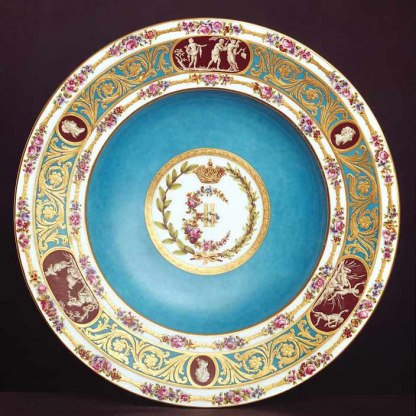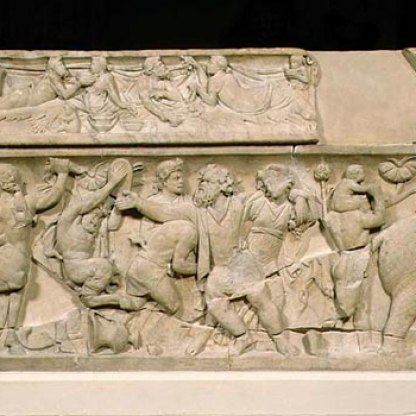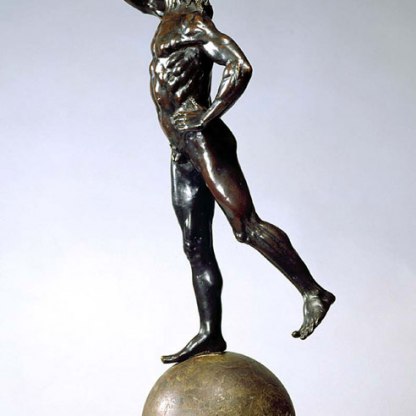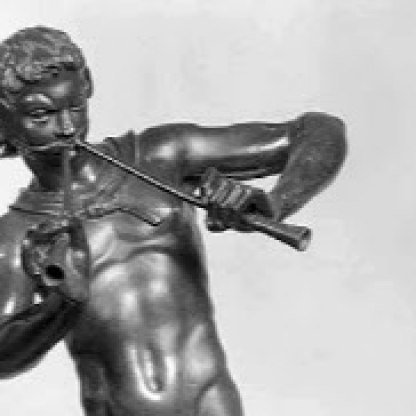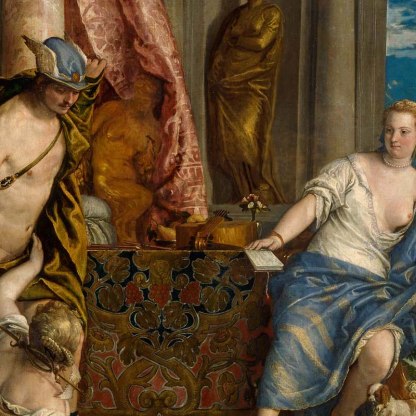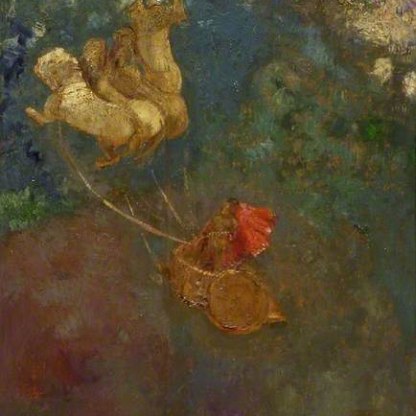The Lyre
The lyre that Handel strums here was not an instrument that he would have had much call to compose for in eighteenth-century England. It is, rather, a conventional attribute of the master musician, a symbol that associates him with two great lyre-players of classical myth: the god Apollo and the mortal hero Orpheus.
In the years after Roubiliac's sculpture was unveiled, there was some confusion about which of these two mythic maestros Handel was supposed to represent. Whose lyre does he hold? In fact, Apollo and Orpheus both used the same instrument, the first lyre ever made.
When the cunning Greek deity Hermes (Roman Mercury) was only a few days old, he scooped out the innards of a mountain tortoise, strung it with cow gut and delighted in the sweet airs it produced. Unfortunately, the herd from which the gut had come had been stolen from Apollo, and the furious god went in search of the thief, swearing bloody vengeance upon him. The music produced by Hermes' lyre, however, eventually soothed Apollo's wrath and he left the infant god unpunished in return for the glorious-sounding new instrument.
With this myth in mind, ancient writers would sometimes refer to the lyre as 'the tortoise'. The reptilian origin of the instrument's sound box is alluded to in the ceiling mouldings in Gallery 3 of the Fitzwilliam.
Apollo became a virtuoso at the new instrument. In art he is almost invariably shown as a beautiful, athletic youth, the embodiment not only of physical perfection but of man's civilised side. His mastery of the lyre was associated with this quality. Apollo was also the god of the sun, and his face, surrounded by solar rays, decorates the top of the instrument held by Roubiliac's Handel.
The two maxims carved into Apollo's temple at Delphi sum up the ideals of rationality and self-control that the god embodied: 'Nothing in excess' and 'Know thyself'. This emphasis on balance, on good measurement, made Apollo an appropriate god of music and he is often shown in art, both classical and later, holding or playing the lyre or its larger equivalent, the cithara – from which we derive the English word 'guitar'. An eighteenth-century blue and white stoneware plaque from the Wedgwood factory shows him in a classical pose: standing naked next to a tripod upon which his lyre rests [C.103-1961].

In this plaque Apollo is dubbed Musagetes ('Leader of the Muses', the nine goddesses who presided over the poetic arts in ancient Greece). As their leader, Apollo was the supreme patron of music and poetry, and, as Wedgwood's plaque suggests, he retained this position in the intellectual imagination long after the rise of Christianity. A mid-eighteenth-century Derby porcelain figurine shows him standing over trophies of the arts: books, painting materials and musical instruments [C.3074-1928]. He wears the traditional laurel wreath, the legacy of his love for the nymph Daphne, who turned into a laurel tree when fleeing the amorous god.
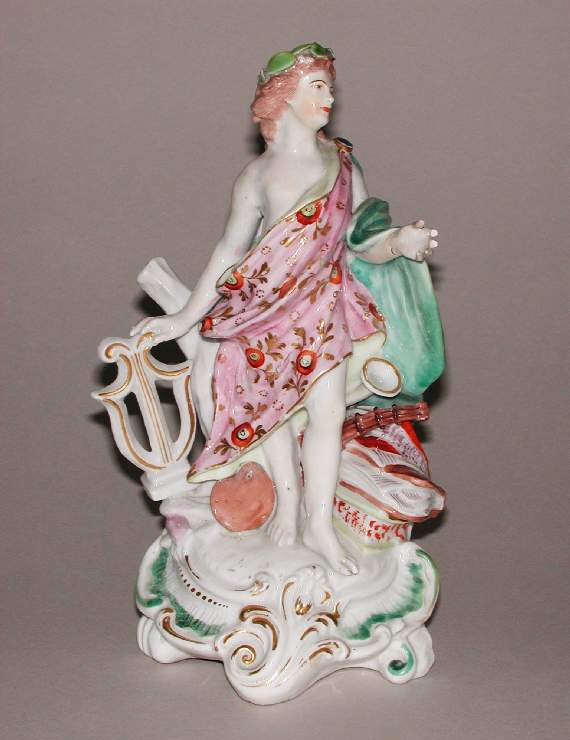
Apollo's relationship with the Muses and the arts accounts for the prominent place his image has in the fabric of the Fitzwilliam Museum. While the nine Muses appear in the pediment over the portico of the Founder's Building, it is Apollo in his chariot that the visitor sees directly above the front door.
But the Muses were not his only companions. Left is a painting in the Fitzwilliam by the eighteenth-century British artist Richard Wilson, showing the Four Seasons dancing in a landscape to the accompaniment of the god's lyre [PD.27-1952].
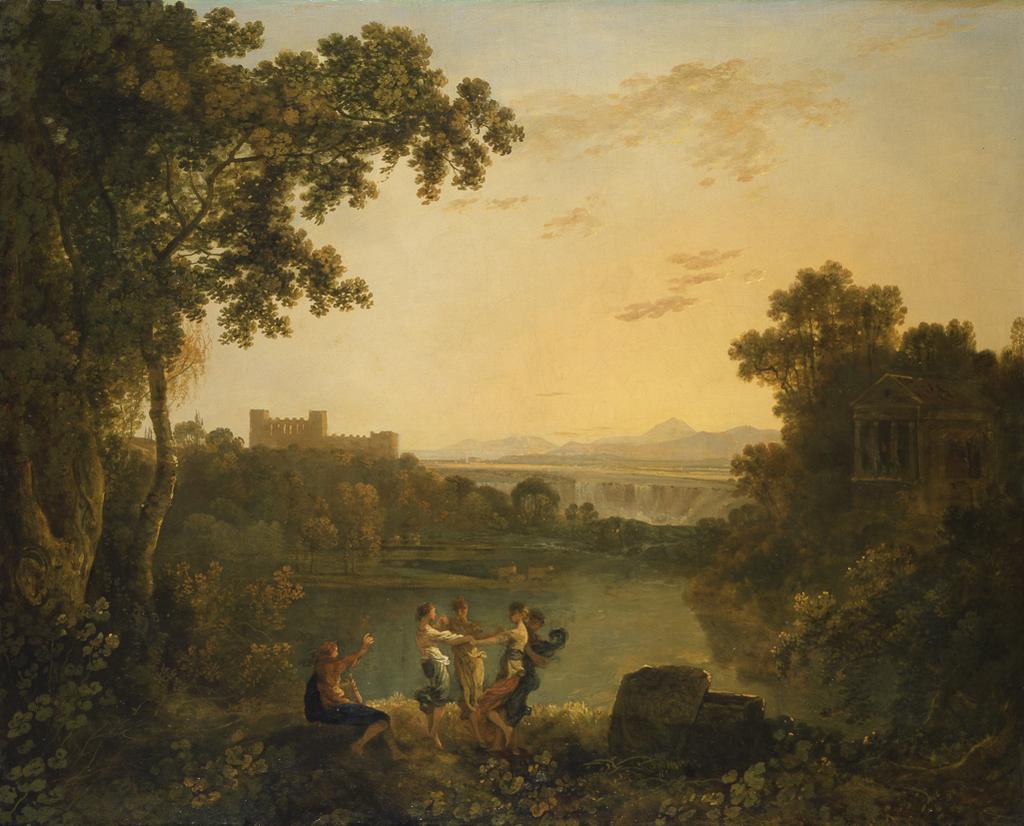
Apollo was proud of his musical abilities, and on more than one occasion competed with players of the pipes. The two different sorts of instrument – stringed and wind – suggested contrasting values in the ancient world. The lyre was the civilised instrument of the cultured Apollo, while the pipe or flute was used by the wilder, nature-dwelling deities.
On one occasion the god Pan, boasting of his mastery of the pipes, was foolish enough to challenge Apollo to a contest. Pan played well, but his rustic ditties were nothing compared to the cosmic harmonies that emanated from the lyre. The mountain god Tmolus, who was judging the contest, did not hesitate to award Apollo the first prize.
Midas, the Phrygian king who had once asked that everything he touch be turned to gold, maintained his reputation for folly, however, by claiming that Apollo was not a worthy winner. To punish his lack of auditory taste Apollo gave Midas asses' ears. A small painting in the Fitzwilliam from 1599, by the German painter Hans Rottenhamer I, depicts the contest before Midas makes his foolish mistake [PD.23-1981].
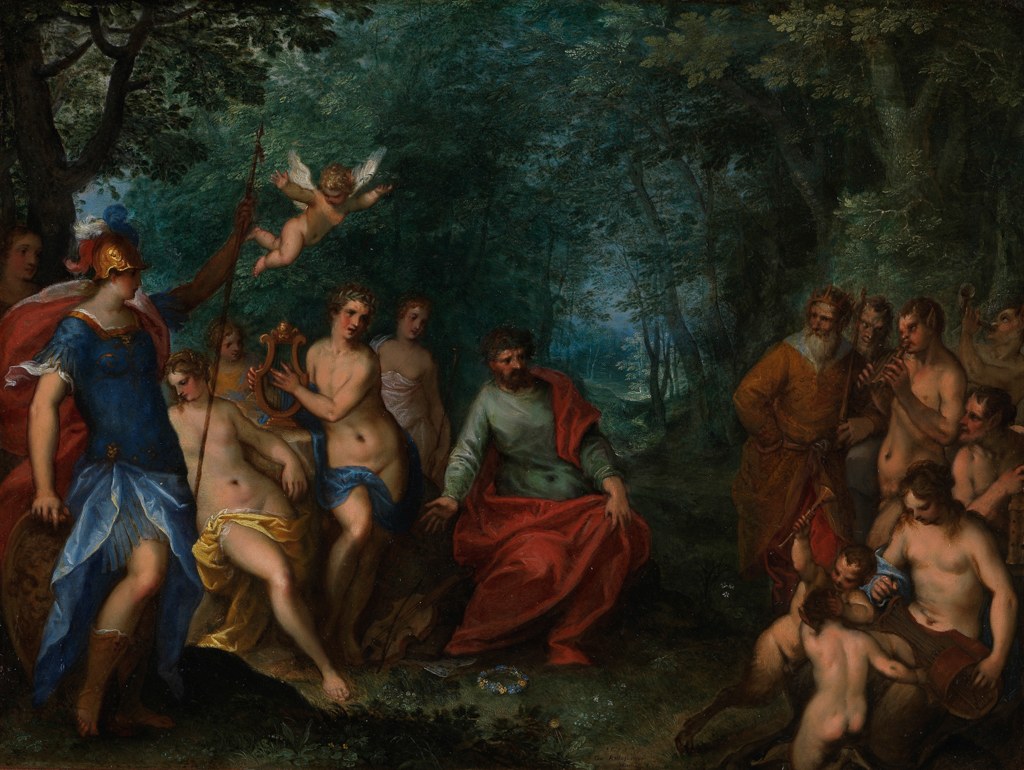
Pan and Midas got away comparatively lightly. The talented flute-playing satyr Marsyas also once rashly challenged Apollo to a musical duel and was not so lucky. It was agreed this time that the winner of the contest could impose whatever penalty he liked upon the loser. The Muses themselves were to be judges.
The first round was tied, both players excelling with their different instruments. Apollo then challenged Marsyas to turn his instrument upside down and to sing at the same time. This was impossible with the flute and when Apollo succeeded with his lyre, he was declared the winner. As a punishment for Marsyas' presumption the god had his challenger hung from a pine tree and flayed alive. The advice to do 'Nothing in excess' had, it seems, been briefly forgotten.
This contest and its bloody aftermath are illustrated in miniature on a plate in the Fitzwilliam from the magnificent neo-classical dinner service made in 1778 for Empress Catherine the Great of Russia [C.51-1961].

The other great lyre-player of classical myth was Orpheus, the son of King Oeagrus of Thrace and Calliope, the Muse of epic poetry. Having inherited Apollo's instrument, he was taught to play it by the Muses.
This musical hero was able to charm not only people and animals with his playing, but even rocks and trees. A grove of mountain oaks in Thrace were said to stand in the pattern of a dance into which his music had once enchanted them. A painting from 1622 by the Dutch artist Roelant Savery in the Fitzwilliam shows a variety of birds and animals in a grove. Orpheus is only just visible playing his lyre in the upper right-hand corner, in the shadow of an enraptured elephant [342].
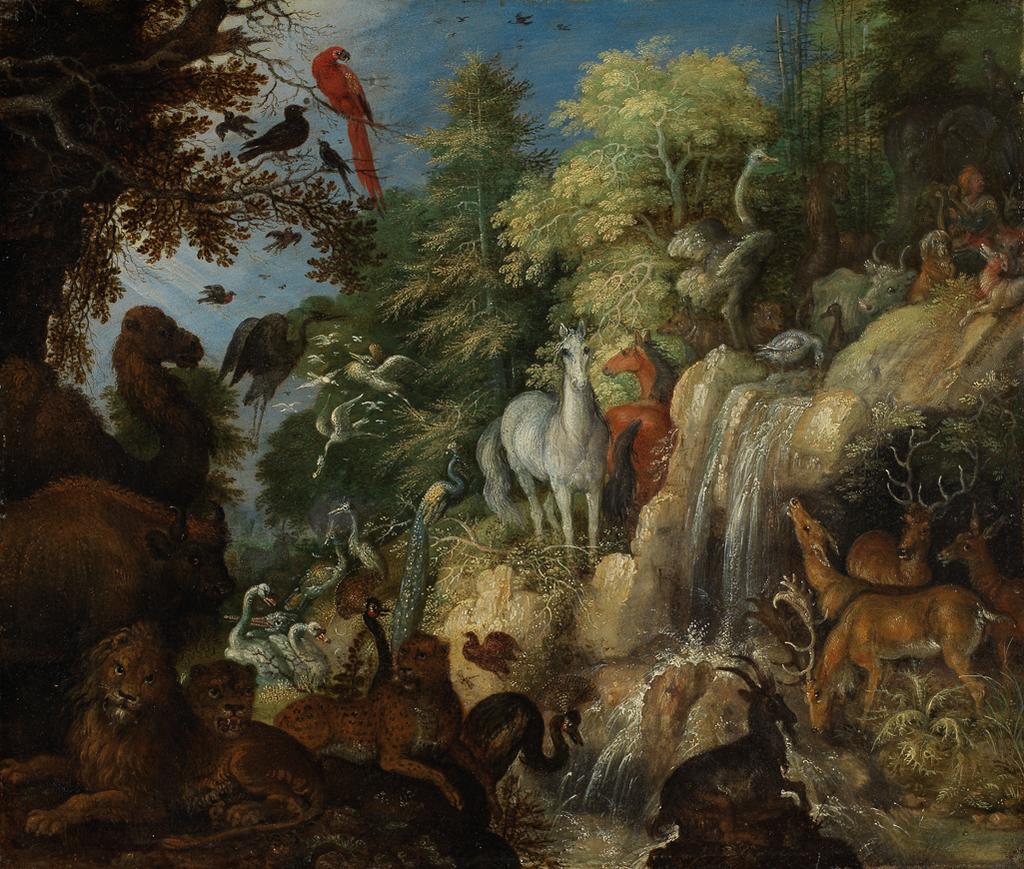
Orpheus accompanied Jason and the Argonauts on their heroic expedition to find the Golden Fleece, and his miraculous music helped them on their voyage. On his return to Thrace, he married Eurydice who, shortly after, suffered a fatal snakebite.
Distraught at his untimely bereavement, Orpheus made his way to the Underworld, charming the ferryman Charon and the three-headed guard-dog Cerberus with his lyre-playing. The beauty of his music helped persuade Hades, king of the Underworld, to return Eurydice to the world above. There was a condition however: Orpheus must not lay eyes upon his wife until she had completed the journey to world above. The couple set off, Orpheus guiding his Eurydice by the sound of his lyre. But turning round too soon, he lost her forever.
To this day, although few people in Europe play the instrument, the lyre remains a potent symbol of musical excellence: it is the motif of the Steinway piano company, who made the instrument used for Sunday concerts in Gallery 3 of the Fitzwilliam.
Other highlight objects you might like
Other pathways and stories you might like
Sign up to our emails
Be the first to hear about our news, exhibitions, events and more…
![Four Seasons dancing in a landscape to the accompaniment of the god's lyre [PD.27-1952]](https://fitz-cms-images.s3.eu-west-2.amazonaws.com/pd.27-1952_201202_adn21_dc1.jpg)
